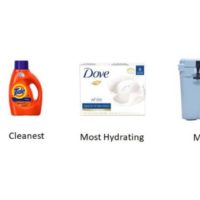
Written by Stacey Danheiser – CEO of SHAKE Marketing Group
A quick look at your competitors will help ensure your business stands out
This article originally appeared on ColoradoBiz Magazine
_________________________________________________________
“So, what makes your solution different from the other vendor?” asks the customer.
“Um…we have loads of other features like x, y and z their product doesn’t!” replies the salesperson.
“Your competitors say they do all that too. And their price is more competitive” says the customer.
No matter what you sell, at some point during the sales cycle, you can be sure your customers will want to know how you compare to your competition.
Are you prepared to answer those questions?
Why Differentiation Matters
According to Miller Heiman, one of the top sales execution challenges is the difficulty of competitive differentiation.
Indeed, based on our own research – differentiation seems to be a prevalent problem. Earlier this year, we published a whitepaper, Lost in the Sea of Sameness, which indicated that every telecommunications company is using similar language and context to communicate what makes them different. Communications are filled with industry jargon, unsubstantiated claims and product-centric language.
This is not just a problem in the telecom industry.
Consider what B2B sales professionals say they need most from their marketing teams – better messaging. Apt messaging reinforces ideas that resonate with customers and clearly differentiates your company and offering.
There is a lot of advice out there to “focus on the customer” and “ignore the competition.” And while I completely agree that you need to focus on your customer, it is poor advice to completely disregard your competition.
Why you can’t overlook your competition
Professional football teams spend hours each week studying their opponents. Offense, defense, special teams – they analyze aspects of past games on film to better understand how their opponent works and discuss details of specific plays. After all, they can’t expect to beat the other team if they don’t know what they’re up against.
Similarly, in business, to truly differentiate yourself from the competition, you have to understand what makes your company unique. By definition, unique means “being the only one of its kind; unlike anything else,” and you certainly can’t declare that without knowing what other choices your customers may be considering.
Whether your business is ready or not, disruption is coming. According to Forrester, big changes are on the horizon that will impact various industries such as: the automation of jobs, artificial intelligence integrating into our health-care system and self-driving cars.
Your future competitors may not even exist yet – but it would be foolish to think that ideas aren’t being worked on right this second to improve and disrupt your industry.
Is Your Value Proposition Unique?
In Value-ology, we define a value proposition as:
‘A promise of expected future value illustrating future relevant and distinct benefits that will outweigh total cost of ownership.”
One of the key tenants in creating a powerful value proposition is that it must be UNIQUE. If you skip this step, you are likely to end up in a price discussion with your customers.
A fun exercise to see how distinct your message is, is to look at the marketing and sales content from your organization and compare it to content from your competitors. Does it sound the same? If you were to remove the company logos from the content, could you tell which company produced it?
“Just because it’s unique doesn’t mean it’s useful. You should be aiming to demonstrate how you can uniquely deliver customer value in terms that the customer recognizes as value.” – Value-ology
Conduct Your Own Competitive Research
Competitive analysis is necessary to specify the difference between you and your competition. Your competition is any business, aside from yours, that your client is considering to solve their issues and fulfill their needs.
The advantages to competitive analysis are to gain an understanding of who your competition is, what they are offering, how they are communicating their offer and how this compares to your business, product or service.
This analysis can be done with a simple approach to breaking down three main areas:
1. Determine Who Your Competitors Are
- Is this organization offering the same or different product/service?
- Is this organization focused on the same or a different target audience?
- Remember your biggest competitor is “complacency” — when the customer chooses to do nothing.
2. Gather Information About Them
- Once you have determined who your competition is, a SWOT analysis can be a great tool to assesses your competitors’ strengths, weaknesses, opportunities and threats. * Your competitors website, marketing collateral and annual report are all great sources of information to reference.
- What is their value proposition? Do they have proof points to support it?
- How are they reaching new customers (i.e. content, marketing and PR programs)?
3. Compare + Contrast
- Finally, you will want to do a comparison to determine how your company stacks up against the competition. You are looking for points of parity vs. points of difference.
- Is your product or solution at parity or differentiated?
- Is your value proposition unique or similar?
- Is your marketing/ sales/ service approach unique or similar?
With proper research and preparation, you can better serve your customers because you will know what to offer to compete (beyond just lowering your price.) In the end, you have to strike a balance between knowing what your competition is up to and fanatically focusing on delivering a superior experience to your own customers.
** Download a free competitive analysis template on our website: SHAKE Marketing.




